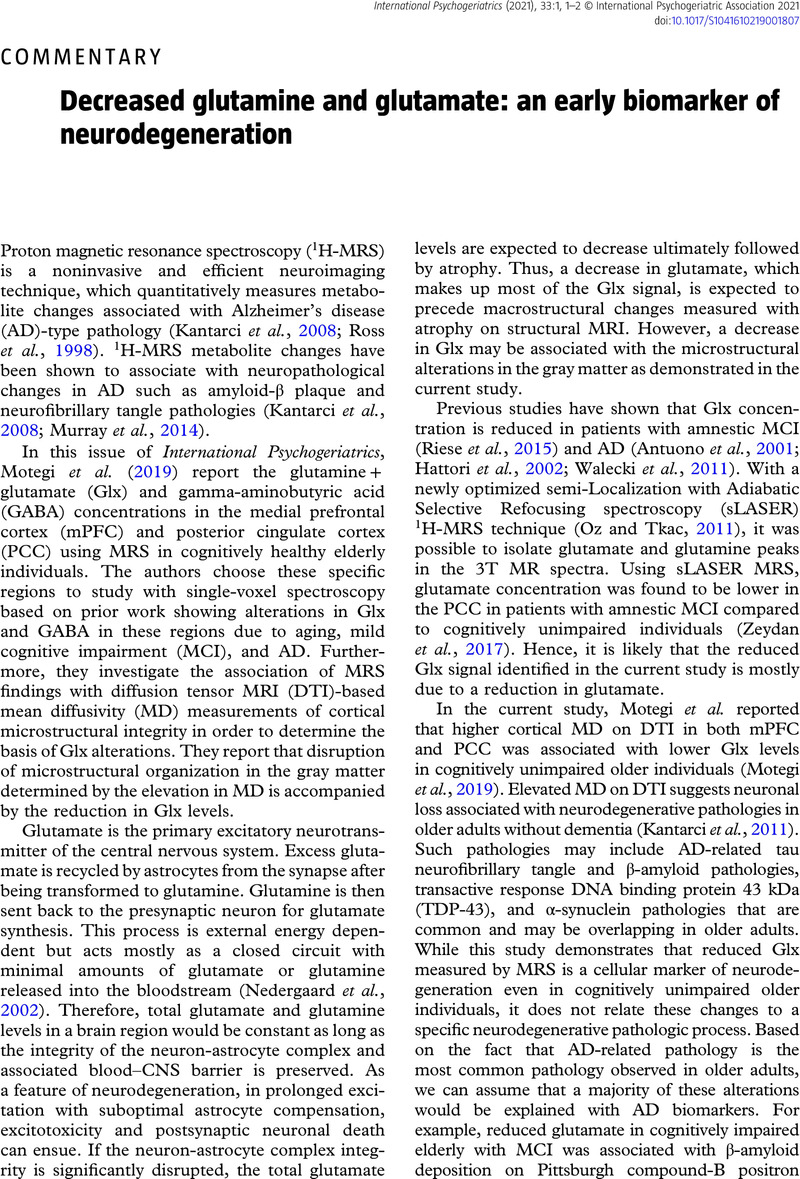Crossref Citations
This article has been cited by the following publications. This list is generated based on data provided by Crossref.
Lanznaster, Débora
Dingeo, Giulia
Samey, Rayhanatou Altine
Emond, Patrick
and
Blasco, Hélène
2022.
Metabolomics as a Crucial Tool to Develop New Therapeutic Strategies for Neurodegenerative Diseases.
Metabolites,
Vol. 12,
Issue. 9,
p.
864.
Araujo, Joseph A.
Segarra, Sergi
Mendes, Jessica
Paradis, Andrea
Brooks, Melissa
Thevarkunnel, Sandy
and
Milgram, Norton W.
2022.
Sphingolipids and DHA Improve Cognitive Deficits in Aged Beagle Dogs.
Frontiers in Veterinary Science,
Vol. 9,
Issue. ,
Kherchouche, Anouar
Ben-Ahmed, Olfa
Guillevin, Carole
Tremblais, Benoit
Julian, Adrien
Fernandez-Maloigne, Christine
and
Guillevin, Rémy
2022.
Attention-guided neural network for early dementia detection using MRS data.
Computerized Medical Imaging and Graphics,
Vol. 99,
Issue. ,
p.
102074.
Mauri, Nico
Richter, Henning
Steffen, Frank
Zölch, Niklaus
and
Beckmann, Katrin M.
2022.
Single-Voxel Proton Magnetic Resonance Spectroscopy of the Thalamus in Idiopathic Epileptic Dogs and in Healthy Control Dogs.
Frontiers in Veterinary Science,
Vol. 9,
Issue. ,
Kara, Firat
Joers, James M.
Deelchand, Dinesh K.
Park, Young Woo
Przybelski, Scott A.
Lesnick, Timothy G.
Senjem, Matthew L.
Zeydan, Burcu
Knopman, David S.
Lowe, Val J.
Vemuri, Prashanthi
Mielke, Michelle M.
Machulda, Mary M.
Jack, Clifford R.
Petersen, Ronald C.
Öz, Gülin
and
Kantarci, Kejal
2022.
1H MR spectroscopy biomarkers of neuronal and synaptic function are associated with tau deposition in cognitively unimpaired older adults.
Neurobiology of Aging,
Vol. 112,
Issue. ,
p.
16.
Epping, Lisa
Schroeter, Christina B.
Nelke, Christopher
Bock, Stefanie
Gola, Lukas
Ritter, Nadine
Herrmann, Alexander M.
Räuber, Saskia
Henes, Antonia
Wasser, Beatrice
Fernandez-Orth, Juncal
Neuhaus, Winfried
Bittner, Stefan
Budde, Thomas
Platten, Michael
Kovac, Stjepana
Seebohm, Guiscard
Ruck, Tobias
Cerina, Manuela
and
Meuth, Sven G.
2022.
Activation of non-classical NMDA receptors by glycine impairs barrier function of brain endothelial cells.
Cellular and Molecular Life Sciences,
Vol. 79,
Issue. 9,
Chakraborty, Pratik
Dey, Abhijit
Gopalakrishnan, Abilash Valsala
Swati, Kumari
Ojha, Shreesh
Prakash, Anand
Kumar, Dhruv
Ambasta, Rashmi K.
Jha, Niraj Kumar
Jha, Saurabh Kumar
and
Dewanjee, Saikat
2023.
Glutamatergic neurotransmission: A potential pharmacotherapeutic target for the treatment of cognitive disorders.
Ageing Research Reviews,
Vol. 85,
Issue. ,
p.
101838.
Flores, Ashley C
Zhang, Xinyuan
Kris-Etherton, Penny M
Sliwinski, Martin J
Shearer, Greg C
Gao, Xiang
and
Na, Muzi
2024.
Metabolomics and Risk of Dementia: A Systematic Review of Prospective Studies.
The Journal of Nutrition,
Vol. 154,
Issue. 3,
p.
826.
Chen, Anna M.
Gajdošík, Martin
Ahmed, Wajiha
Ahn, Sinyeob
Babb, James S.
Blessing, Esther M.
Boutajangout, Allal
de Leon, Mony J.
Debure, Ludovic
Gaggi, Naomi
Gajdošík, Mia
George, Ajax
Ghuman, Mobeena
Glodzik, Lidia
Harvey, Patrick
Juchem, Christoph
Marsh, Karyn
Peralta, Rosemary
Rusinek, Henry
Sheriff, Sulaiman
Vedvyas, Alok
Wisniewski, Thomas
Zheng, Helena
Osorio, Ricardo
and
Kirov, Ivan I.
2024.
Retrospective analysis of Braak stage– and APOE4 allele–dependent associations between MR spectroscopy and markers of tau and neurodegeneration in cognitively unimpaired elderly.
NeuroImage,
Vol. 297,
Issue. ,
p.
120742.
Sheikh-Bahaei, Nasim
Chen, Michelle
and
Pappas, Ioannis
2024.
Biomarkers for Alzheimer’s Disease Drug Development.
Vol. 2785,
Issue. ,
p.
115.
Abbaspour, Fatemeh
Mohammadi, Niusha
Amiri, Hassan
Cheraghi, Susan
Ahadi, Reza
and
Hormozi-Moghaddam, Zeinab
2024.
Applications of magnetic resonance spectroscopy in diagnosis of neurodegenerative diseases: A systematic review.
Heliyon,
Vol. 10,
Issue. 9,
p.
e30521.
Chen, Tianlu
Pan, Fengfeng
Huang, Qi
Xie, Guoxiang
Chao, Xiaowen
Wu, Lirong
Wang, Jie
Cui, Liang
Sun, Tao
Li, Mengci
Wang, Ying
Guan, Yihui
Zheng, Xiaojiao
Ren, Zhenxing
Guo, Yuhuai
Wang, Lu
Zhou, Kejun
Zhao, Aihua
Guo, Qihao
Xie, Fang
and
Jia, Wei
2024.
Metabolic phenotyping reveals an emerging role of ammonia abnormality in Alzheimer’s disease.
Nature Communications,
Vol. 15,
Issue. 1,



